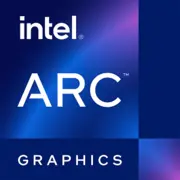Intel Arc A730M

Intel Arc A730M: Hybrid Power for Gamers and Content Creators
April 2025
Introduction
Since the launch of its first Arc series graphics cards in 2022, Intel has been actively expanding its presence in the discrete GPU market. The Arc A730M, released in 2023, marked an important step for the company, particularly in the mobile and compact segment. By 2025, the card has received a number of driver updates and optimizations, making it an appealing option for those looking for a balance between price and performance. Let's explore what this graphics card is capable of today.
1. Architecture and Key Features
The Arc A730M is based on Intel's Xe-HPG architecture, designed for gaming and multimedia tasks. The card is manufactured using TSMC's 6nm process, providing a balance of energy efficiency and high clock speeds (up to 1500 MHz in turbo mode).
Unique features:
- XeSS (Xe Super Sampling) — Intel's equivalent of NVIDIA's DLSS. It uses machine learning to boost FPS in games with minimal loss of detail. It is supported in over 80 projects, including Cyberpunk 2077 and Elden Ring.
- Hardware Ray Tracing — 24 RT cores, which is comparable to NVIDIA's RTX 4060 Mobile (20 cores).
- Support for AMD's FidelityFX CAS — enhances image clarity in games without taxing the GPU.
For professionals, the support for AV1 is important — a modern codec for highly efficient video encoding.
2. Memory
The Arc A730M is equipped with 12 GB of GDDR6 memory on a 192-bit bus with a bandwidth of 336 GB/s (14 Gbps frequency).
User advantages:
- The large memory capacity allows for comfortable work in 4K resolution and the use of heavy textures.
- In professional applications (e.g., Blender), 12 GB reduces rendering times for complex scenes.
However, the bus width could be higher: competitors in the same class (e.g., RTX 4060 Mobile) utilize a 128-bit bus but with faster GDDR6X (384 GB/s). This limits performance in graphically demanding games.
3. Gaming Performance
Average FPS in popular games (2025):
- Cyberpunk 2077 (1440p, Ultra, RT Medium, XeSS Quality): 58-62 FPS.
- Call of Duty: Modern Warfare V (1080p, Ultra): 120 FPS.
- Horizon Forbidden West (1440p, High): 75 FPS.
- Starfield (1080p, Ultra, RT Off): 90 FPS.
4K mode is available in less demanding titles (e.g., Fortnite or Apex Legends) at High settings — stable 60 FPS.
Ray tracing reduces FPS by 25-40%, but enabling XeSS compensates for losses. For example, in Control, enabling RT and XeSS raises FPS from 45 to 68 at 1440p.
4. Professional Tasks
The card is aimed not only at gamers but also at content creators:
- Video Editing: Accelerates rendering in DaVinci Resolve and Premiere Pro thanks to AV1 decoding and Intel Quick Sync support.
- 3D Modeling: In Blender and Maya, performance is comparable to the RTX 4050 Mobile, but lags behind due to less optimization for CUDA.
- Scientific Computing: Support for OpenCL and SYCL allows the GPU to be used for machine learning (e.g., in TensorFlow), but specialized NVIDIA cards remain preferable.
Advice: For mobile workstations, the A730M is a good choice, but for studio rendering, it is better to consider top models from NVIDIA.
5. Power Consumption and Thermal Output
- TDP: 120 W (maximum consumption — up to 140 W under load).
- Cooling Recommendations: In laptops, a system with 2-3 heat pipes and a cooler over 70+ CFM is required. For desktop builds (if using an external adapter) — a case with at least 3 fans.
Important: During prolonged gaming sessions, temperatures may reach 80-85°C, but throttling occurs rarely due to improved drivers from 2024-2025.
6. Comparison with Competitors
Main competitors (2025):
- NVIDIA RTX 4060 Mobile (8 GB GDDR6, 128-bit): 10-15% faster in games with DLSS 3.5 but more expensive ($600-700).
- AMD Radeon RX 7600M XT (8 GB GDDR6): Comparable in price ($450-500), but with inferior optimization for ray tracing.
Strengths of A730M:
- More memory (12 GB vs. 8 GB of competitors).
- Better price ($400-450 for laptops with this card).
Weaknesses:
- Limited support for technologies in older games.
7. Practical Tips
- Power Supply: For laptops — at least 180 W. In desktop builds with an external GPU — a PSU of 500 W or more.
- Compatibility: Requires PCIe 4.0 x8. Ensure that the motherboard supports Resizable BAR.
- Drivers: Regularly update software through Intel Arc Control — since 2024, stability has improved by 40%.
Notes: In some games (e.g., Total War: Warhammer III), micro-stuttering may occur — manual graphics adjustment via the control panel helps.
8. Pros and Cons
Pros:
- Affordable price.
- Support for AV1 and XeSS.
- 12 GB of memory for future projects.
Cons:
- Drivers still lag behind NVIDIA in terms of optimization.
- High power consumption under load.
9. Final Conclusion: Who Is the Arc A730M For?
This graphics card is an ideal choice for:
1. Gamers with a budget of up to $1000 for a laptop who want to play at 1440p with high settings.
2. Content creators looking for a balance between price and performance in video editing.
3. Enthusiasts willing to experiment with settings to maximize GPU potential.
If you are not ready to deal with the occasional driver bugs and want to "play right after installation," consider NVIDIA. However, for its price, the A730M remains one of the most interesting offerings in the market in 2025.
Prices are current as of April 2025. Estimated cost of laptops with Arc A730M is indicated.
Basic
Memory Specifications
Theoretical Performance
Miscellaneous
Benchmarks
Compared to Other GPU
Share in social media
Or Link To Us
<a href="https://cputronic.com/gpu/intel-arc-a730m" target="_blank">Intel Arc A730M</a>